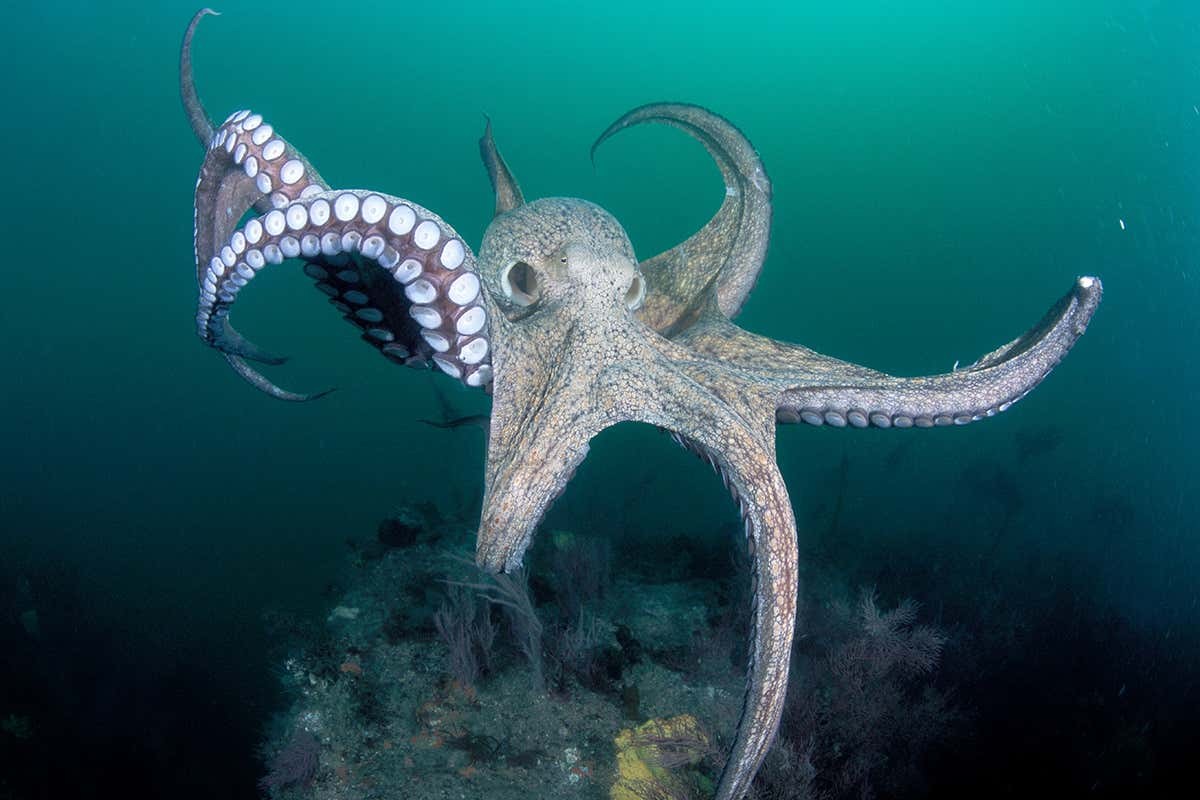Octopuses are fascinating creatures, renowned for their intelligence, agility, and unique physical attributes. One of the most intriguing questions about these cephalopods is: how many brains do they actually possess? The answer might surprise you – an octopus doesn’t just have one brain, but nine! This remarkable arrangement is a key factor in their complex behavior and survival strategies.
To understand this unique feature, let’s delve into the octopus’s anatomy. As cephalopods, meaning “head-foot,” octopuses, along with squids, cuttlefish, and nautiluses, have a body plan that’s quite different from vertebrates. One striking characteristic they share is blue blood, a consequence of using hemocyanin, a copper-rich protein, instead of iron-based hemoglobin to transport oxygen. This less efficient oxygen-carrying system partly explains why octopuses have evolved three hearts, but what about their brains?
Octopus’s body plan necessitates a sophisticated nervous system to control their eight arms, each capable of independent movement and complex tasks. This is where the multiple brain system comes into play. An octopus has one central brain, located in its head, and an additional brain in each of its eight arms.
The Central Brain and the Eight Arm Brains
The central brain of an octopus, situated between its eyes, is the command center. It’s responsible for higher-level functions like decision-making, learning, and coordinating movements across the entire body. However, a significant portion of an octopus’s nervous system is decentralized. Each arm contains its own cluster of neurons, effectively acting as a mini-brain.
These arm brains are remarkably autonomous. They can control the movements of their respective arms independently of the central brain. This means an octopus arm can react to stimuli, explore its surroundings, and even perform complex actions like grabbing prey or manipulating objects without direct instructions from the central brain. Imagine each arm having its own mind, capable of solving problems and executing tasks on its own!
This distributed nervous system is incredibly advantageous for octopuses. It allows for rapid, localized responses and frees the central brain to focus on more complex cognitive functions. For example, an octopus arm can independently work to open a clam while the central brain is focused on monitoring the environment for predators or planning its next move.
Why So Many Brains? Evolutionary Advantages
The evolution of multiple brains in octopuses is closely linked to their active and complex lifestyle. Octopuses are skilled hunters, masters of camouflage, and adept problem-solvers. Their eight arms are essential tools for these activities, enabling them to explore intricate environments, capture prey with precision, and manipulate objects with dexterity.
Having independent control of each arm through localized brains significantly enhances an octopus’s flexibility and responsiveness. It allows for intricate and coordinated movements that would be difficult to achieve with a single, centralized brain controlling all eight arms simultaneously. This decentralized system allows for faster reaction times in each arm, crucial for hunting and escaping predators.
Furthermore, brain tissue is energetically expensive. By distributing neural processing across multiple brains, the octopus may optimize energy usage while maximizing processing power. This distributed intelligence network contributes to the octopus’s remarkable agility and adaptability in diverse marine environments.
Supporting the Brains: Hearts and Blue Blood
The octopus’s three hearts play a crucial role in supporting its energy-demanding brains. Two branchial hearts pump blood through the gills to collect oxygen, while a central systemic heart circulates oxygenated blood to the rest of the body, including the nine brains. This efficient circulatory system ensures that the brain tissue, which is known to be fuel-intensive, receives an adequate supply of oxygen to function optimally. This intricate interplay between hearts, blood, and brains underscores the sophisticated biological adaptations that enable the octopus’s unique intelligence and capabilities.
Conclusion: A Marvel of Natural Engineering
So, to answer the question directly: an octopus has nine brains – one central brain and eight smaller brains, one in each arm. This unique neurological architecture highlights the octopus as a marvel of natural engineering. It’s a testament to the diverse ways intelligence can evolve and be structured in the animal kingdom. The distributed brain system of the octopus allows for remarkable autonomy of its arms, contributing to its complex behaviors, hunting prowess, and overall survival success in the marine world. Understanding the “How Many Brains Does An Octopus Have” question truly opens a window into the fascinating biology and intelligence of these incredible creatures.

